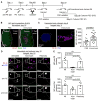Endocytosis and recycling of immune complexes by follicular dendritic cells enhances B cell antigen binding and activation
- PMID: 23770227
- PMCID: PMC3773956
- DOI: 10.1016/j.immuni.2013.02.023
Endocytosis and recycling of immune complexes by follicular dendritic cells enhances B cell antigen binding and activation
Abstract
Stromal-derived follicular dendritic cells (FDCs) are a major reservoir for antigen that are essential for formation of germinal centers, the site where memory and effector B cells differentiate. A long-standing question is how FDCs retain antigen in its native form for extended periods and how they display it to specific B cells. Here we found that FDCs acquired complement-coated immune complexes (ICs) from noncognate B cells via complement receptors 1 and 2 (CD35 and CD21, respectively) and rapidly internalized them by an actin-dependent pathway. ICs were retained intact within a nondegradative cycling compartment and were displayed periodically on the cell surface where they were accessible to antigen-specific B cells. This would explain how antigens are protected from damage and retained over long periods of time, while remaining accessible for B cells.
Copyright © 2013 Elsevier Inc. All rights reserved.
Figures






References
-
- Bergtold A, Desai DD, Gavhane A, Clynes R. Cell surface recycling of internalized antigen permits dendritic cell priming of B cells. Immunity. 2005;23:503–514. - PubMed
Publication types
MeSH terms
Substances
Grants and funding
LinkOut - more resources
Full Text Sources
Other Literature Sources
Molecular Biology Databases

